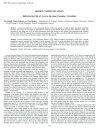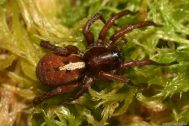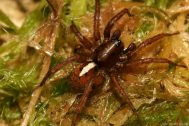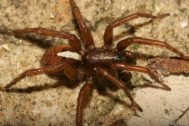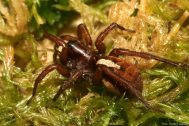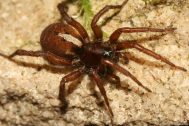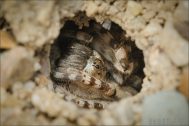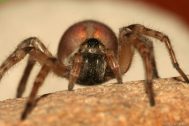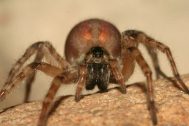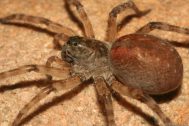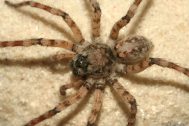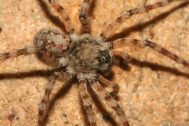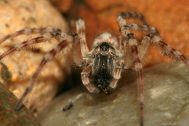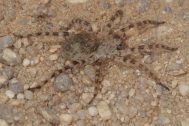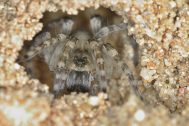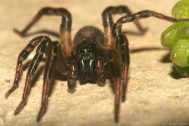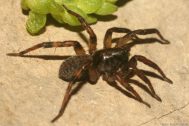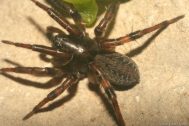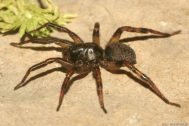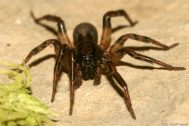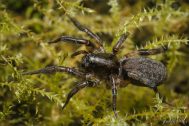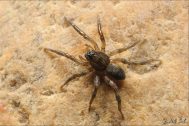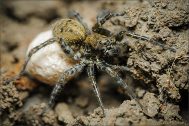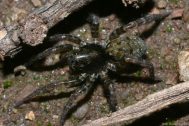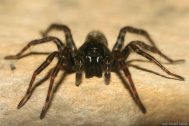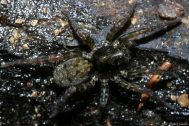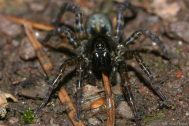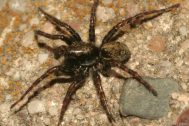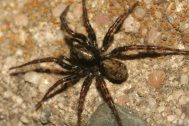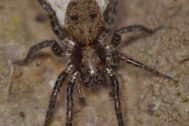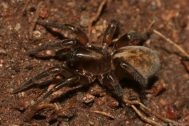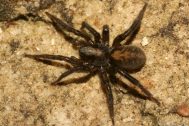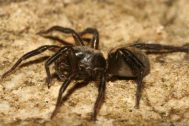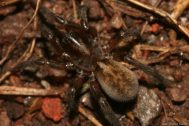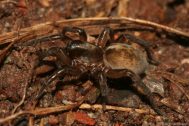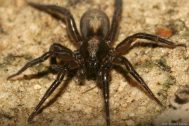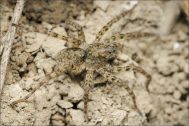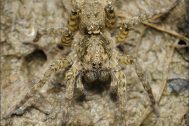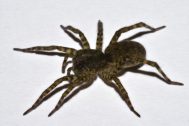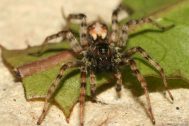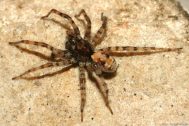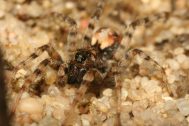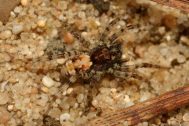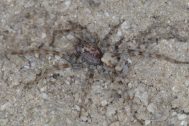| Records by time | |||||
|---|---|---|---|---|---|
| Lycosidae | 0-1900 | 1901-1950 | 1951-2000 | 2001+ | ∑ |
 Arctosa alpigena lamperti
Dahl, 1908 Strongly endangered Arctosa alpigena lamperti
Dahl, 1908 Strongly endangered |
37× | 12× | 49× | ||
 Arctosa cinerea
(Fabricius, 1777) Criticaly endangered Arctosa cinerea
(Fabricius, 1777) Criticaly endangered |
6× | 3× | 16× | 24× | 49× |
 Arctosa figurata
(Simon, 1876) Endangered Arctosa figurata
(Simon, 1876) Endangered |
184× | 48× | 232× | ||
 Arctosa leopardus
(Sundevall, 1833) Endangered Arctosa leopardus
(Sundevall, 1833) Endangered |
5× | 5× | 77× | 74× | 161× |
 Arctosa lutetiana
(Simon, 1876) Endangered Arctosa lutetiana
(Simon, 1876) Endangered |
1× | 113× | 62× | 176× | |
 Arctosa maculata
(Hahn, 1822) Strongly endangered Arctosa maculata
(Hahn, 1822) Strongly endangered |
4× | 2× | 13× | 28× | 47× |
 Arctosa perita
(Latreille, 1799) Strongly endangered Arctosa perita
(Latreille, 1799) Strongly endangered |
1× | 13× | 36× | 50× | |
Bibliography
Pavouk 53 (12/2022)
Pavouci České republiky; Pavučenka dlouhovlasá po dlouhé době!; Významné nálezy pavouků od Nových Mlýnů aneb najde ten, kdo nehledá; Můžeme v terénu či z fotografií spolehlivě rozeznat středoevropské křižáky rodu Zygiella?; Fenomén rekultivací v povrchových dolech pod Krušnými horami a výskyt pavouků; Výskyt pavučenky Staveleya pusilla (Menge, 1869) také v severozápadních Čechách; Dovolená s pavouky; Poznámka k výskytu sekáče Nemastoma bidentatum sparsum (Gruber & Martens, 1968) v Ohřeckém údolí; Inventarizace 2021; Výzva k spolupráci na World Spider Trait databáze; Kutilky (Sphecidae) – specialisté na lov pavouků XI: Sceliphron, Trypoxylon, Pison a Miscopus; Lumci bez křídel; Byli jsme na arachnologické konferenci v německém Greifswaldu!; Pozdně letní exkurze na Mostecko; 119. seminář České arachnologické společnosti; Česká bibliografie; Nové knihy; Pokyny pro autoryVýsledky faunistického průzkumu pavouků a sekáčů na vybraných lokalitách na území NP Podyjí v roce 2020
Arctosa cinerea – nový druh pavouka (Araneae: Lycosidae) pro Ústecký kraj (severozápadní Čechy).
První nález slíďáka Arctosa cinerea pro Ústecký kraj.Výsledky faunistického průzkumu pavouků a sekáčů na vybraných lokalitách na území NP Podyjí v roce 2019
A total of 114 spider species from 25 families and one harvestmen species were found during the zoological research at several sites in the Podyjí National Park during 2019. Of them, forty-one species are listed in the Red List of spiders of the Czech Republic. Four new species for the Podyjí NP were recorded – Callilepis nocturna (Linnaeus, 1758), Euryopis laeta (Westring, 1861), Phrurolithus minimus C. L. Koch, 1839 and Trichoncus auritus (L. Koch, 1869). Among the most interesting species, four critically endangered spiders – Civizelotes caucasius (L. Koch, 1866), Phrurolithus szilyi Herman, 1879, Gnaphosa modestior Kulczyński, 1897 and Eresus moravicus Řezáč, 2008 should be mentioned. Other rare species include Acartauchenius scurrilis (O. Pickard-Cambridge, 1873), Agyneta fuscipalpa (C. L. Koch, 1836), Arctosa figurata (Simon, 1876), Atypus affinis Eichwald, 1830, Bassaniodes robustus (Hahn, 1832), Callilepis schuszteri (Herman, 1879), Centromerus incilium (L. Koch, 1881), Centromerus leruthi Fage, 1933, Cheiracanthium effossum Herman, 1879, Drassyllus villicus (Thorell, 1875), Euryopis quinqueguttata Thorell, 1875, Frontinellina frutetorum (C. L. Koch, 1835), Gibbaranea gibbosa (Walckenaer, 1802), Gnaphosa opaca Herman, 1879, Haplodrassus cognatus (Westring, 1861), Haplodrassus dalmatensis (L. Koch, 1866), Haplodrassus minor (O. Pickard-Cambridge, 1879), Heterotheridion nigrovariegatum (Simon, 1873), Kishidaia conspicua (L. Koch, 1866), Leptorchestes berolinensis (C. L. Koch, 1846), Minicia marginella (Wider, 1834), Phrurolithus pullatus Kulczyński, 1897, Trichopterna cito (O. Pickard-Cambridge, 1873), Walckenaeria simplex Chyzer, 1894, Zelotes erebeus (Thorell, 1871) and Zora manicata Simon, 1878.Výsledky faunistického průzkumu pavouků a sekáčů na vybraných lokalitách na území NP Podyjí v roce 2019
A total of 114 spider species from 25 families and one harvestmen species were found during the zoological research at several sites in the Podyjí National Park during 2019. Of them, forty-one species are listed in the Red List of spiders of the Czech Republic. Four new species for the Podyjí NP were recorded – Callilepis nocturna (Linnaeus, 1758), Euryopis laeta (Westring, 1861), Phrurolithus minimus C. L. Koch, 1839 and Trichoncus auritus (L. Koch, 1869). Among the most interesting species, four critically endangered spiders – Civizelotes caucasius (L. Koch, 1866), Phrurolithus szilyi Herman, 1879, Gnaphosa modestior Kulczyński, 1897 and Eresus moravicus Řezáč, 2008 should be mentioned. Other rare species include Acartauchenius scurrilis (O. Pickard-Cambridge, 1873), Agyneta fuscipalpa (C. L. Koch, 1836), Arctosa figurata (Simon, 1876), Atypus affinis Eichwald, 1830, Bassaniodes robustus (Hahn, 1832), Callilepis schuszteri (Herman, 1879), Centromerus incilium (L. Koch, 1881), Centromerus leruthi Fage, 1933, Cheiracanthium effossum Herman, 1879, Drassyllus villicus (Thorell, 1875), Euryopis quinqueguttata Thorell, 1875, Frontinellina frutetorum (C. L. Koch, 1835), Gibbaranea gibbosa (Walckenaer, 1802), Gnaphosa opaca Herman, 1879, Haplodrassus cognatus (Westring, 1861), Haplodrassus dalmatensis (L. Koch, 1866), Haplodrassus minor (O. Pickard-Cambridge, 1879), Heterotheridion nigrovariegatum (Simon, 1873), Kishidaia conspicua (L. Koch, 1866), Leptorchestes berolinensis (C. L. Koch, 1846), Minicia marginella (Wider, 1834), Phrurolithus pullatus Kulczyński, 1897, Trichopterna cito (O. Pickard-Cambridge, 1873), Walckenaeria simplex Chyzer, 1894, Zelotes erebeus (Thorell, 1871) and Zora manicata Simon, 1878.Pavouci a sekáči (Arachnida: Araneae, Opiliones) Klánovického lesa a jeho okolí v Praze.
The studied locality, i.e. Klánovický les Forest is situated on the edge of Prague, one of the most polluted areas in the Czech Republic. Thanks to large area the forest acts as an isolation from agrochemicals, thus allowing the existence of some habitats sensitive to eutrophisation, in particular peat-bogs, heaths, bare sandy soils, and Molinia meadows. The habitats harbour unusually high species diversity of spiders and harvestmen: the author recorded 286 spider and 11 harvestman species there, which is approximately one third of the Czech fauna. Sixty one of them are red-listed in the Czech Republic. Peat-bog linyphiid Saaristoa abnormis, and steppe lycosid Alopecosa schmidti and linyphiid Panamomops inconspicuus are listed as endangered. Local small peat-bogs offer suitable conditions for disappearing lycosids Hygrolycosa rubrofasciata, Pirata piscatorius and Piratula uliginosa, while heaths harbour the disappearing Oxyopes ramosus. Water spider Argyroneta aquatica has recently been found in small pools in ditches along the railway. Littoral vegetation is inhabited by Theridiosoma gemmosum and the jumping spider Calositticus floricola. Disturbed soil surface of wet meadows harbours the wolf spider Arctosa leopardus. Some species have recently appeared at the site, for example Dysdera hungarica, the harvestman Nemastoma bidentatum sparsum or the crab spider Synema globosum. The first two were probably introduced there by man, the latter probably expands due to climate change. The author suggests to keep these habitats without woody vegetation to protect local high species diversity there.Pavouk 47 (12/2019)
Pavouci České republiky; Steatoda nobilis – černý pasažér přistižen v ČR; Dolomedes; Proč si myslím, že to je Palliduphantes pillichi (Kulczyński, 1915) (aneb hozená rukavice nebo ručník); Nález snovačky kuželové Achaeridion conigerum (Simon, 1914) v Krušných horách; Poznámka k článku Snovačka půdní (Steatoda triangulosa) ve volné přírodě v ČR; Třesavka jižní (Holocnemus pluchei) – poznámky z předvánočního úklidu v Brně: Překvapivý nález; Pavouci (Araneae) bývalé pískovny v Komořanech v Praze; Žluté misky – méně obvyklá metoda odchytu pavouků; Hrabalky (Pompilidae) – specialisté na lov pavouků V: rod Episyron; Krátké ohlédnutí za zářijovou exkurzí na Radotínských skalách; Slovenská arachnologická konference ve Východné; 117. Arachnologický seminář v Plzni; Česká bibliografie; Britská bibliografie - The Newsletter 145; Nové knihy; Pokyny pro autoryPříspěvek k fauně pavouků vybraných lokalit střední Moravy
Během exkurze České arachnologické společnosti konané 31. 5. – 3. 6. 2018 v CHKO Litovelské Pomoraví a v oblasti Velkého a Malého Kosíře na Prostějovsku bylo nasbíráno 188 druhů pavouků, z nichž 17 je zařazeno mezi ohrožené až kriticky ohrožené druhy. Mezi nejvýznamnější nálezy patří Atypus affinis, Arctosa maculata, Dolomedes fimbriatus,Enoplognatha caricis, Hypsosinga heri nebo Neottiura suaveolens.
Pavouci vybraných lokalit Mostecka, Chomutovska a Žatecka (severozápadní Čechy).
Arachnologický průzkum na Mostecku a Chomutovsku byl doposud soustředěn zejména na Krušné hory (BUCHAR a HAJER 1999, 2005, 2010. ROUŠAR 2011. RŮŽIČKA a HAJER 2002, 2003), jednotlivé sběry z okolí jsou také zahrnuty v katalogu pavouků ČR (BUCHAR a RŮŽIČKA 2002), na Chomutovsku je známo také několik publikovaných sběrů Antonína Roušara (ROUŠAR 2009, 2015, 2016). Přesto údaje o výskytu pavouků z mnoha lokalit scházejí. Proto od 1. do 4. června 2017 uspořádalo Oblastní muzeum v Mostě arachnologické exkurze do nejbližšího okolí Mostu a Chomutova, kterých se zúčastnili členové České arachnologické společnosti. Jako cílové byly zvoleny lokality, na kterých se systematicky pavoukovci dosud nesbírali, ale i lokality, které by vzhledem ke svým přírodním hodnotám mohly být v budoucnu zařazeny mezi zvláště chráněná území. Tento článek předkládá seznam všech druhů pavouků, kteří byli během akce zjištěni.
Předběžný průzkum pavouků navrhované přírodní rezervace „Mokřiny pod Křížovou horou“.
V práci jsou prezentovány výsledky orientačního průzkumu v navrhované přírodní rezervaci „Mokřiny pod Křížovou horou“ rozkládající se v blízkosti obce Červená Voda ve východních Čechách. Zaznamenán byl výskyt 79 druhů pavouků. K významnějším nálezům patří například Arctosa leopardus, Heliophanus dampfi, Erigonella ignobilis, Diplocephalus permixtus a Walckenaeria unicornis.
Pavouci (Araneae) a střevlíkovití brouci (Coleoptera, Carabidae) vybraných vřesovišť v západních Čechách.
Results of the exploration of the araneofauna and the entomofauna in West Bohemian heathlands are presented. Spiders and carabid beetles were collected during the vegetation seasons in 2011 and 2012 by the method of pitfall trapping. In total, 3188 specimens of 171 Araneae species and 2168 specimens of 93 Carabid species were determined. The most frequent spiders were Xerolycosa nemoralis (Westring, 1861), a common forest species. The following identified species are listed among the endangered spiders in the Czech Republic in the category „endangered“: Alopecosa schmidti (Hahn, 1835), Micaria dives (Lucas, 1846), Peponocranium orbiculatum (O. P.-Cambridge, 1882), in the category „vulnerable“: Centromerus incilium (L. Koch, 1881), Evansia merens O. P.-Cambridge, 1900, Metopobactrus prominulus (O. P.-Cambridge, 1872), Arctosa figurata (Simon, 1876), Arctosa lutetiana (Simon, 1876), Pardosa nigriceps (Thorell, 1872), Gnaphosa bicolor (Hahn, 1833), Xysticus striatipes L. Koch, 1870, Evarcha laetabunda (C. L. Koch, 1846) and Trichopterna cito (Blackwall, 1841). The most remarkable species of the Carabids were the Amara equestris equestris (Duftschmid, 1812), Amara pulpani Kult, 1949, Bradycellus ruficollis (Stephens, 1828), Carabus arcensis arcensis Herbst, 1784, Carabus problematicus harcyniae Sturm, 1815, Cymindis axillaris axillaris (Fabricius, 1794), Cymindis vaporariorum (Linné, 1758), Masoreus wetterhallii wetterhallii (Gyllenhal, 1813), Olisthopus rotundatus rotundatus (Paykull, 1790). Studied material was reposited at the Department of Zoology of the West Bohemian Museum in Pilsen.
Pavouci NPR Zástudánčí. Spiders of Zástudánčí National Nature Reserve.
V roce 2012–2013 byl proveden první inventarizační průzkum pavouků v NPR Zástudánčí. Na území rezervace bylo zjištěno 117 druhů pavouků z 21 čeledí. Druhy Arctosa cinerea, Caviphantes saxetorum, Clubiona germanica a Sitticus dzieduszyckii jsou zařazeny v červeném seznamu pavouků ČR a jsou zároveň nejvýznamnějšími nálezy. Pavučenka Caviphantes saxetorum je novým druhem pro Českou republiku. Nejzajímavější společenstvo pavouků bylo zjištěno na štěrkových náplavech v meandru řeky Moravy.
Epigeic Spiders from Lowland Oak Woodlands in the South Moravia Region (Czech Republic).
This paper presents spider faunistics from abandoned coppice oak forest stands located along the South Moravia region. Spiders were collected from May to July 2012 by pitfall trapping at eight different localities. We collected 1945 adult spiders representing 20 families, 53 genera, and 90 species. More than one-third of all the species are known to be xerothermophilous with ecological restrictions to open and partly shaded habitats such as forest-steppe and sparse forests which belong to endangered habitats along central Europe. The most abundant species were Pardosa alacris, Pardosa lugubris and Arctosa lutetiana from the family Lycosidae. In the surveyed area, 24 species were found listed in the Red List of Threatened Species in the Czech Republic (CR – 1 species, EN – 2 species, VU – 15 species, LC – 6 species). In general, we discovered a substantially diversified spider community with a large presence of rare and endangered species characteristic for open and xeric habitats.
Slíďák břehový (Arctosa cinerea) na štěrkových lavicích řeky Bečvy u obce Skalička.
A rich population of the Giant Riverbank Wolf Spider (Arctosa cinerea) was observed on the naturalised stretch of the Bečva river. The Red List of the Czech Spiders evaluates this species as critically endangered. Not only this rare spider occurs at the site, but other endangered invertebrates also find appropriate conditions here and thus the locality should be protected. The realisation of the plan to build a dam near the village of Skalička would lead to the changes of the water regime that could cause the extermination of the Giant Riverbank Wolf Spider at the Bečva river.
Additional disturbances as a beneficial tool for restoration of post-mining sites: a multi-taxa approach.
Open interior sands represent a highly threatened habitat in Europe. In recent times, their associated organisms have often found secondary refuges outside their natural habitats, mainly in sand pits. We investigated the effects of different restoration approaches, i.e. spontaneous succession without additional disturbances, spontaneous succession with additional disturbances caused by recreational activities, and forestry reclamation, on the diversity and conservation values of spiders, beetles, flies, bees and wasps, orthopterans and vascular plants in a large sand pit in the Czech Republic, Central Europe. Out of 406 species recorded in total, 112 were classified as open sand specialists and 71 as threatened. The sites restored through spontaneous succession with additional disturbances hosted the largest proportion of open sand specialists and threatened species. The forestry reclamations, in contrast, hosted few such species. The sites with spontaneous succession without disturbances represent a transition between these two approaches. While restoration through spontaneous succession favours biodiversity in contrast to forestry reclamation, additional disturbances are necessary to maintain early successional habitats essential for threatened species and open sand specialists. Therefore, recreational activities seem to be an economically efficient restoration tool that will also benefit biodiversity in sand pits.
Slíďák břehový – evropský pavouk roku 2007.
Stejně jako ornitologové volí ptáka roku, tak i my arachnologové jsme se rozhodli pro každý rok určit svého favorita. Naší ankety se zúčastňují kolegové téměř ze všech zemí Evropské unie. Vybíráme proto ze seznamu druhů, které se ve všech těchto státech vyskytují. Zatímco na území České republiky byla zaznamenána bezmála tisícovka druhů pavouků, těch společných s ostatními členskými státy EU je pouze 99. Letos odevzdalo nejvíce evropských arachnologů svůj hlas slíďákovi břehovému, který se tak stal pavoukem roku 2007.
Slíďák břehový [Arctosa cinerea (Fabricius, 1777)], s délkou těla až 17 mm, je hned po slíďákovi tatarském (Lycosa singoriensis) naším největším zástupcem čeledi slíďákovitých (Lycosidae). Nestaví sítě, ale při lovu kořisti volně pobíhá po zemi. Vyznačuje se kontrastním zbarvením vyvinutým zvláště výrazně u samců. Pokud však nehnutě sedí na písku nebo štěrku, toto zbarvení působí jako dokonalá kamufláž. Jednotlivé populace se vzájemně liší poměrem velikosti světlých a tmavých skvrn v závislosti na barvě substrátu na jejich stanovišti.
Gallery
Arctosa alpigena lamperti
Arctosa cinerea
Arctosa figurata
Arctosa leopardus
Arctosa lutetiana
Arctosa maculata
Arctosa perita
Statistics
By month
By altitude
By collecting method (763 used records)
| Zemní past | Males | Females | Juveniles | Records |
|---|---|---|---|---|
| Arctosa alpigena lamperti Dahl, 1908 | 98 | 29 | 42 | 37 |
| Arctosa cinerea (Fabricius, 1777) | 10 | 4 | 0 | 5 |
| Arctosa figurata (Simon, 1876) | 240 | 79 | 21 | 147 |
| Arctosa leopardus (Sundevall, 1833) | 634 | 195 | 35 | 80 |
| Arctosa lutetiana (Simon, 1876) | 433 | 130 | 6 | 106 |
| Arctosa maculata (Hahn, 1822) | 17 | 8 | 1 | 8 |
| Arctosa perita (Latreille, 1799) | 61 | 11 | 3 | 28 |
| Neurčeno | Males | Females | Juveniles | Records |
| Arctosa cinerea (Fabricius, 1777) | 5 | 21 | 50 | 24 |
| Arctosa figurata (Simon, 1876) | 105 | 37 | 0 | 59 |
| Arctosa leopardus (Sundevall, 1833) | 7 | 0 | 1 | 27 |
| Arctosa lutetiana (Simon, 1876) | 49 | 8 | 2 | 42 |
| Arctosa maculata (Hahn, 1822) | 8 | 8 | 1 | 20 |
| Arctosa perita (Latreille, 1799) | 0 | 2 | 11 | 8 |
| Individuální sběr | Males | Females | Juveniles | Records |
| Arctosa alpigena lamperti Dahl, 1908 | 7 | 15 | 3 | 12 |
| Arctosa cinerea (Fabricius, 1777) | 5 | 14 | 2 | 15 |
| Arctosa figurata (Simon, 1876) | 14 | 12 | 1 | 18 |
| Arctosa leopardus (Sundevall, 1833) | 27 | 40 | 4 | 44 |
| Arctosa lutetiana (Simon, 1876) | 36 | 14 | 8 | 19 |
| Arctosa maculata (Hahn, 1822) | 9 | 12 | 5 | 17 |
| Arctosa perita (Latreille, 1799) | 11 | 5 | 1 | 9 |
| Prosev | Males | Females | Juveniles | Records |
| Arctosa figurata (Simon, 1876) | 5 | 0 | 1 | 7 |
| Arctosa leopardus (Sundevall, 1833) | 3 | 2 | 0 | 4 |
| Arctosa lutetiana (Simon, 1876) | 13 | 5 | 0 | 6 |
| Smyk | Males | Females | Juveniles | Records |
| Arctosa figurata (Simon, 1876) | 1 | 0 | 0 | 1 |
| Arctosa leopardus (Sundevall, 1833) | 1 | 0 | 0 | 1 |
| Arctosa lutetiana (Simon, 1876) | 0 | 1 | 1 | 2 |
| Arctosa perita (Latreille, 1799) | 1 | 1 | 0 | 2 |
| Fotografie | Males | Females | Juveniles | Records |
| Arctosa cinerea (Fabricius, 1777) | 0 | 1 | 3 | 2 |
| Arctosa maculata (Hahn, 1822) | 1 | 2 | 0 | 2 |
| Arctosa perita (Latreille, 1799) | 1 | 0 | 0 | 1 |
| Pozorování | Males | Females | Juveniles | Records |
| Arctosa cinerea (Fabricius, 1777) | 0 | 1 | 0 | 3 |
| Arctosa leopardus (Sundevall, 1833) | 0 | 0 | 0 | 1 |
| Žlutá miska | Males | Females | Juveniles | Records |
| Arctosa leopardus (Sundevall, 1833) | 1 | 0 | 0 | 1 |
| Arctosa perita (Latreille, 1799) | 1 | 1 | 0 | 2 |
| Sklepávání | Males | Females | Juveniles | Records |
| Arctosa leopardus (Sundevall, 1833) | 0 | 1 | 0 | 1 |
| Arctosa lutetiana (Simon, 1876) | 12 | 1 | 0 | 1 |
| Vysavač | Males | Females | Juveniles | Records |
| Arctosa leopardus (Sundevall, 1833) | 1 | 1 | 0 | 1 |
| Males | Females | Juveniles | Records |
By biotope (764 used records)
| Neurčeno | Males | Females | Juveniles | Records |
|---|---|---|---|---|
| Arctosa cinerea (Fabricius, 1777) | 5 | 11 | 0 | 26 |
| Arctosa figurata (Simon, 1876) | 152 | 54 | 1 | 90 |
| Arctosa leopardus (Sundevall, 1833) | 519 | 148 | 2 | 58 |
| Arctosa lutetiana (Simon, 1876) | 25 | 9 | 1 | 53 |
| Arctosa maculata (Hahn, 1822) | 4 | 8 | 3 | 20 |
| Arctosa perita (Latreille, 1799) | 51 | 12 | 10 | 32 |
| Lesostepní doubravy | Males | Females | Juveniles | Records |
| Arctosa figurata (Simon, 1876) | 40 | 14 | 6 | 34 |
| Arctosa lutetiana (Simon, 1876) | 185 | 34 | 10 | 39 |
| Skalní stepi na vápenci | Males | Females | Juveniles | Records |
| Arctosa figurata (Simon, 1876) | 44 | 17 | 2 | 31 |
| Arctosa lutetiana (Simon, 1876) | 58 | 18 | 3 | 13 |
| Rašeliniště | Males | Females | Juveniles | Records |
| Arctosa alpigena lamperti Dahl, 1908 | 81 | 31 | 3 | 37 |
| Arctosa leopardus (Sundevall, 1833) | 1 | 1 | 0 | 4 |
| Arctosa lutetiana (Simon, 1876) | 0 | 1 | 0 | 1 |
| Suché louky | Males | Females | Juveniles | Records |
| Arctosa figurata (Simon, 1876) | 39 | 15 | 9 | 25 |
| Arctosa lutetiana (Simon, 1876) | 9 | 3 | 0 | 7 |
| Arctosa perita (Latreille, 1799) | 11 | 1 | 0 | 2 |
| Mokré louky | Males | Females | Juveniles | Records |
| Arctosa leopardus (Sundevall, 1833) | 96 | 41 | 13 | 29 |
| Těžebny písku a jiných nezpevněných hornin | Males | Females | Juveniles | Records |
| Arctosa cinerea (Fabricius, 1777) | 11 | 27 | 52 | 12 |
| Arctosa figurata (Simon, 1876) | 1 | 0 | 0 | 1 |
| Arctosa leopardus (Sundevall, 1833) | 4 | 4 | 3 | 7 |
| Arctosa perita (Latreille, 1799) | 8 | 2 | 1 | 7 |
| Bylinné porosty břehů | Males | Females | Juveniles | Records |
| Arctosa cinerea (Fabricius, 1777) | 3 | 1 | 0 | 3 |
| Arctosa leopardus (Sundevall, 1833) | 1 | 5 | 1 | 8 |
| Arctosa maculata (Hahn, 1822) | 6 | 2 | 0 | 5 |
| Kamenolomy | Males | Females | Juveniles | Records |
| Arctosa figurata (Simon, 1876) | 7 | 0 | 0 | 3 |
| Arctosa leopardus (Sundevall, 1833) | 6 | 4 | 1 | 4 |
| Arctosa lutetiana (Simon, 1876) | 32 | 3 | 0 | 7 |
| Suché doubravy | Males | Females | Juveniles | Records |
| Arctosa figurata (Simon, 1876) | 7 | 3 | 0 | 6 |
| Arctosa lutetiana (Simon, 1876) | 20 | 12 | 0 | 6 |
| Xerotermní travinobylinná společenstva | Males | Females | Juveniles | Records |
| Arctosa figurata (Simon, 1876) | 1 | 1 | 1 | 2 |
| Arctosa lutetiana (Simon, 1876) | 32 | 6 | 1 | 9 |
| Luční ostřicové mokřady | Males | Females | Juveniles | Records |
| Arctosa alpigena lamperti Dahl, 1908 | 23 | 13 | 42 | 11 |
| Výsadby jehličnanů | Males | Females | Juveniles | Records |
| Arctosa figurata (Simon, 1876) | 10 | 4 | 1 | 4 |
| Arctosa lutetiana (Simon, 1876) | 37 | 6 | 0 | 7 |
| Louky | Males | Females | Juveniles | Records |
| Arctosa leopardus (Sundevall, 1833) | 0 | 0 | 0 | 1 |
| Arctosa lutetiana (Simon, 1876) | 32 | 8 | 0 | 9 |
| Lužní lesy nížin | Males | Females | Juveniles | Records |
| Arctosa leopardus (Sundevall, 1833) | 16 | 1 | 7 | 9 |
| Arctosa maculata (Hahn, 1822) | 1 | 0 | 0 | 1 |
| Štěrkové břehy řek | Males | Females | Juveniles | Records |
| Arctosa cinerea (Fabricius, 1777) | 0 | 1 | 0 | 2 |
| Arctosa leopardus (Sundevall, 1833) | 0 | 1 | 0 | 1 |
| Arctosa maculata (Hahn, 1822) | 4 | 4 | 0 | 7 |
| Močály | Males | Females | Juveniles | Records |
| Arctosa leopardus (Sundevall, 1833) | 14 | 13 | 3 | 9 |
| Lesní okraje | Males | Females | Juveniles | Records |
| Arctosa figurata (Simon, 1876) | 11 | 1 | 0 | 5 |
| Arctosa lutetiana (Simon, 1876) | 4 | 1 | 0 | 4 |
| Reliktní bory na skalách | Males | Females | Juveniles | Records |
| Arctosa figurata (Simon, 1876) | 13 | 6 | 1 | 8 |
| Arctosa lutetiana (Simon, 1876) | 1 | 0 | 0 | 1 |
| Rákosiny a orobincové porosty stojatých vod | Males | Females | Juveniles | Records |
| Arctosa leopardus (Sundevall, 1833) | 5 | 4 | 0 | 9 |
| Suché křoviny | Males | Females | Juveniles | Records |
| Arctosa figurata (Simon, 1876) | 2 | 0 | 0 | 1 |
| Arctosa lutetiana (Simon, 1876) | 85 | 51 | 0 | 8 |
| Písčiny | Males | Females | Juveniles | Records |
| Arctosa perita (Latreille, 1799) | 5 | 4 | 4 | 8 |
| Písčité břehy | Males | Females | Juveniles | Records |
| Arctosa cinerea (Fabricius, 1777) | 0 | 0 | 3 | 2 |
| Arctosa leopardus (Sundevall, 1833) | 0 | 4 | 0 | 3 |
| Arctosa maculata (Hahn, 1822) | 3 | 2 | 0 | 3 |
| Břehy tekoucích vod | Males | Females | Juveniles | Records |
| Arctosa cinerea (Fabricius, 1777) | 0 | 0 | 0 | 2 |
| Arctosa leopardus (Sundevall, 1833) | 2 | 1 | 0 | 2 |
| Arctosa maculata (Hahn, 1822) | 3 | 5 | 4 | 4 |
| Kamenité břehy potoků | Males | Females | Juveniles | Records |
| Arctosa cinerea (Fabricius, 1777) | 1 | 0 | 0 | 1 |
| Arctosa maculata (Hahn, 1822) | 14 | 5 | 0 | 6 |
| Haldy a výsypky | Males | Females | Juveniles | Records |
| Arctosa cinerea (Fabricius, 1777) | 0 | 1 | 0 | 1 |
| Arctosa leopardus (Sundevall, 1833) | 0 | 3 | 0 | 3 |
| Arctosa perita (Latreille, 1799) | 0 | 1 | 0 | 1 |
| Porosty borůvek | Males | Females | Juveniles | Records |
| Arctosa figurata (Simon, 1876) | 5 | 2 | 0 | 5 |
| Kamenité suti nižších poloh | Males | Females | Juveniles | Records |
| Arctosa lutetiana (Simon, 1876) | 14 | 6 | 0 | 4 |
| Acidofilní bory | Males | Females | Juveniles | Records |
| Arctosa figurata (Simon, 1876) | 9 | 3 | 1 | 4 |
| Louky a pastviny | Males | Females | Juveniles | Records |
| Arctosa figurata (Simon, 1876) | 3 | 1 | 0 | 4 |
| Slaniska | Males | Females | Juveniles | Records |
| Arctosa leopardus (Sundevall, 1833) | 5 | 8 | 6 | 4 |
| Dubohabřiny | Males | Females | Juveniles | Records |
| Arctosa lutetiana (Simon, 1876) | 1 | 0 | 0 | 3 |
| Přirozené lesy | Males | Females | Juveniles | Records |
| Arctosa figurata (Simon, 1876) | 2 | 0 | 0 | 1 |
| Arctosa lutetiana (Simon, 1876) | 0 | 1 | 0 | 1 |
| Ostřicové porosty stojatých vod | Males | Females | Juveniles | Records |
| Arctosa leopardus (Sundevall, 1833) | 2 | 0 | 0 | 2 |
| Pastviny | Males | Females | Juveniles | Records |
| Arctosa figurata (Simon, 1876) | 0 | 1 | 0 | 1 |
| Arctosa lutetiana (Simon, 1876) | 0 | 0 | 2 | 1 |
| Paseky | Males | Females | Juveniles | Records |
| Arctosa figurata (Simon, 1876) | 1 | 0 | 0 | 1 |
| Arctosa leopardus (Sundevall, 1833) | 0 | 0 | 1 | 1 |
| Stinné skály nižších poloh | Males | Females | Juveniles | Records |
| Arctosa figurata (Simon, 1876) | 15 | 5 | 1 | 2 |
| Zahradnicky utvářené zahrady a parky | Males | Females | Juveniles | Records |
| Arctosa leopardus (Sundevall, 1833) | 2 | 0 | 0 | 2 |
| Horské bučiny | Males | Females | Juveniles | Records |
| Arctosa lutetiana (Simon, 1876) | 8 | 0 | 0 | 2 |
| Vrbové křoviny - vlhké (vrbové) křoviny | Males | Females | Juveniles | Records |
| Arctosa leopardus (Sundevall, 1833) | 0 | 0 | 2 | 1 |
| Arctosa maculata (Hahn, 1822) | 0 | 4 | 0 | 1 |
| Vřesoviště nižších poloh | Males | Females | Juveniles | Records |
| Arctosa figurata (Simon, 1876) | 2 | 0 | 0 | 2 |
| Rašelinné bory | Males | Females | Juveniles | Records |
| Arctosa alpigena lamperti Dahl, 1908 | 1 | 0 | 0 | 1 |
| Bahnité břehy | Males | Females | Juveniles | Records |
| Arctosa leopardus (Sundevall, 1833) | 1 | 0 | 0 | 1 |
| Suché lesní lemy | Males | Females | Juveniles | Records |
| Arctosa figurata (Simon, 1876) | 0 | 1 | 0 | 1 |
| Lesy | Males | Females | Juveniles | Records |
| Arctosa lutetiana (Simon, 1876) | 0 | 0 | 0 | 1 |
| Stojaté a pomalu tekoucí vody | Males | Females | Juveniles | Records |
| Arctosa leopardus (Sundevall, 1833) | 0 | 0 | 1 | 1 |
| Mokřady | Males | Females | Juveniles | Records |
| Arctosa leopardus (Sundevall, 1833) | 0 | 1 | 0 | 1 |
| Ostatní pole | Males | Females | Juveniles | Records |
| Arctosa leopardus (Sundevall, 1833) | 1 | 0 | 0 | 1 |
| Úhory | Males | Females | Juveniles | Records |
| Arctosa figurata (Simon, 1876) | 1 | 0 | 0 | 1 |
| Males | Females | Juveniles | Records |



















